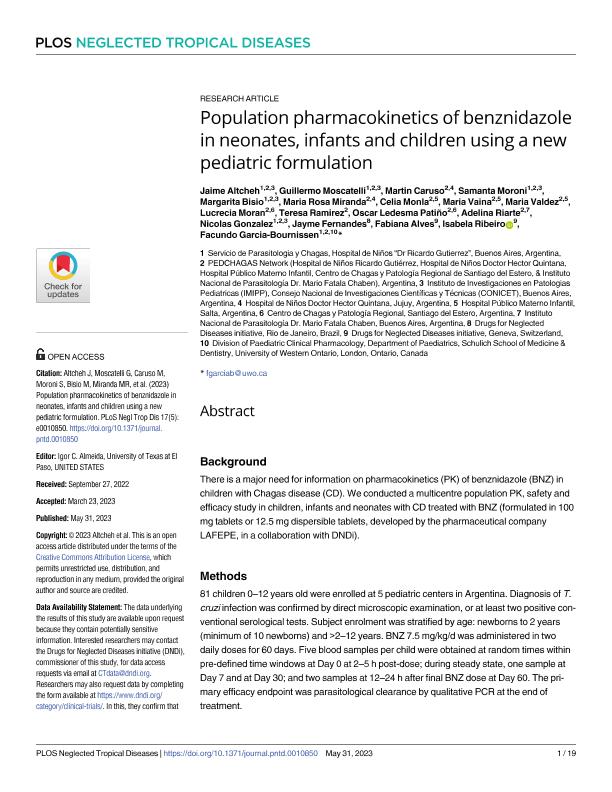Artículo
Population pharmacokinetics of benznidazole in neonates, infants and children using a new pediatric formulation
Altcheh, Jaime Marcelo ; Moscatelli, Guillermo
; Moscatelli, Guillermo ; Caruso, Martín; Moroni, Samanta; Bisio, Margarita María Catalina
; Caruso, Martín; Moroni, Samanta; Bisio, Margarita María Catalina ; Miranda, Maria Rosa; Monla, Celia Rita; Vaina, Maria; Valdez, Maria; Moran, Lucrecia; Ramirez, Teresa; Patiño, Oscar Ledesma; Riarte, Adelina Rosa; Gonzalez, Nicolas; Fernandes, Jayme; Alves, Fabiana; Ribeiro, Isabela; Garcia Bournissen, Facundo
; Miranda, Maria Rosa; Monla, Celia Rita; Vaina, Maria; Valdez, Maria; Moran, Lucrecia; Ramirez, Teresa; Patiño, Oscar Ledesma; Riarte, Adelina Rosa; Gonzalez, Nicolas; Fernandes, Jayme; Alves, Fabiana; Ribeiro, Isabela; Garcia Bournissen, Facundo
 ; Moscatelli, Guillermo
; Moscatelli, Guillermo ; Caruso, Martín; Moroni, Samanta; Bisio, Margarita María Catalina
; Caruso, Martín; Moroni, Samanta; Bisio, Margarita María Catalina ; Miranda, Maria Rosa; Monla, Celia Rita; Vaina, Maria; Valdez, Maria; Moran, Lucrecia; Ramirez, Teresa; Patiño, Oscar Ledesma; Riarte, Adelina Rosa; Gonzalez, Nicolas; Fernandes, Jayme; Alves, Fabiana; Ribeiro, Isabela; Garcia Bournissen, Facundo
; Miranda, Maria Rosa; Monla, Celia Rita; Vaina, Maria; Valdez, Maria; Moran, Lucrecia; Ramirez, Teresa; Patiño, Oscar Ledesma; Riarte, Adelina Rosa; Gonzalez, Nicolas; Fernandes, Jayme; Alves, Fabiana; Ribeiro, Isabela; Garcia Bournissen, Facundo
Fecha de publicación:
05/2023
Editorial:
Public Library of Science
Revista:
Neglected Tropical Diseases
ISSN:
1935-2735
Idioma:
Inglés
Tipo de recurso:
Artículo publicado
Clasificación temática:
Resumen
Background There is a major need for information on pharmacokinetics (PK) of benznidazole (BNZ) in children with Chagas disease (CD). We conducted a multicentre population PK, safety and efficacy study in children, infants and neonates with CD treated with BNZ (formulated in 100 mg tablets or 12.5 mg dispersible tablets, developed by the pharmaceutical company LAFEPE, in a collaboration with DNDi). Methods 81 children 0–12 years old were enrolled at 5 pediatric centers in Argentina. Diagnosis of T. cruzi infection was confirmed by direct microscopic examination, or at least two positive conventional serological tests. Subject enrolment was stratified by age: Newborns to 2 years (minimum of 10 newborns) and >2–12 years. BNZ 7.5 mg/kg/d was administered in two daily doses for 60 days. Five blood samples per child were obtained at random times within pre-defined time windows at Day 0 at 2–5 h post-dose; during steady state, one sample at Day 7 and at Day 30; and two samples at 12–24 h after final BNZ dose at Day 60. The primary efficacy endpoint was parasitological clearance by qualitative PCR at the end of treatment. Results Forty-one (51%) patients were under 2 years of age (including 14 newborns <1 month of age). Median age at enrolment was 22 months (mean: 43.2; interquartile range (IQR) 7–72 months). The median measured BNZ Cmax was 8.32 mg/L (IQR 5.95–11.8; range 1.79– 19.38). Median observed BNZ Cmin (trough) concentration was 2 mg/L (IQR 1.25–3.77; range 0.14–7.08). Overall median simulated Css was 6.3 mg/L (IQR 4.7–8.5 mg/L). CL/F increased quickly during the first month of postnatal life and reached adult levels after approximately 10 years of age. Negative qPCR was observed at the end of treatment in all 76 patients who completed the treatment. Five patients discontinued treatment (3 due to AEs and 2 due to lack of compliance). Conclusion We observed lower BNZ plasma concentrations in infants and children than those previously reported in adults treated with comparable mg/kg doses. Despite these lower concentrations, pediatric treatment was well tolerated and universally effective, with a high response rate and infrequent, mild AEs. Trial registration Registered in clinicaltrials.gov #NCT01549236.
Archivos asociados
Licencia
Identificadores
Colecciones
Articulos(IMIPP)
Articulos de INSTITUTO MULTIDISCIPLINARIO DE INVESTIGACIONES EN PATOLOGIAS PEDIATRICAS
Articulos de INSTITUTO MULTIDISCIPLINARIO DE INVESTIGACIONES EN PATOLOGIAS PEDIATRICAS
Articulos(SEDE CENTRAL)
Articulos de SEDE CENTRAL
Articulos de SEDE CENTRAL
Citación
Altcheh, Jaime Marcelo; Moscatelli, Guillermo; Caruso, Martín; Moroni, Samanta; Bisio, Margarita María Catalina; et al.; Population pharmacokinetics of benznidazole in neonates, infants and children using a new pediatric formulation; Public Library of Science; Neglected Tropical Diseases; 17; 5; 5-2023; 1-19
Compartir
Altmétricas



